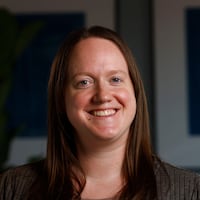Each year since about 2010, Moss and her family come together in honor of her grandmother Cindy Knab, who died in 2017 following a 7-year battle with the progressive disease. She was 75 years old.
“We just want to raise awareness and show support for everyone else that goes through this,” Moss said during Saturday’s walk. “We love the community energy and getting everyone together; it’s always a good time.”
Moss was joined by her grandfather Thomas Knab, who was married to Cindy for more than 50 years.
Thomas Knab, 85, said he walks each year in memory of his wife. He fondly recalled the day he met her in the early 1960s.
“It was at Old River Park. I’d gone with a couple of buddies of mine, and she was there with her sister,” Knab said. “My buddies and I were in a canoe and we happened to accidently run into theirs.”
From there, one small act of fate led to a lifetime of memories together.
“I walk in her honor,” he said.
Moss highlighted the effect the disease — which currently has no cure — can have on those closest to a patient, many of whom take on the responsibility of full-time, round-the-clock caregiving.
“It really took a toll on everyone, especially (Thomas), as her husband; they were extremely close,” Moss said. “He was her caregiver until the very end.”
Barnett said the Walk to End Alzheimer’s event allows those who have experience with the disease — which affects a person’s memory, thinking skills and behavior — to know that they are supported.
“When you’re out in that crowd and you see everybody else, you begin to feel that you’re not alone,” she said.
To learn more about programs and services offered by the Alzheimer’s Association, and to find ways to donate, visit www.alz.org.
“We have social engagement programs that get people out and help keep their mind active, which is crucial,” Barnett said. “Plus, we want caregivers to know that they aren’t expected to handle it all; it’s so hard and we want them to know there’s help out there.”
About the Author


